-
CENTRES
Progammes & Centres
Location
 PDF Download
PDF Download 
INTRODUCTION
India has had longstanding diplomatic relations with Africa but the relationship has evolved in the last two decades. From the early 1990s, there was a distinct break in India's policy towards Africa—from political solidarities based on shared commitments to anti-colonialism, anti-racism, non-alignment and Afro-Asian solidarity, to the expansion of 1 trade and investment f lows. India's engagement with Africa became more structured with the inception of the India- Africa Summits beginning in 2008. The Third India-Africa Forum Summit held in New Delhi in October 2015, which was the biggest diplomatic event hosted by India, saw the participation of all 54 African countries. The government of India made a number of important announcements in the Summit: an additional credit line of US$ 10 billion; a grant assistance of US$ 600 million; India-Africa Health Fund of US$ 10 million; 50,000 scholarships for African students in India; and an India-Africa Development Fund of US$ 100 2 million. The Summit was followed by highlevel visits to Africa by Indian leaders. India's Vice President, Mohammad Hamid Ansari visited two North African countries, Morocco and Tunisia, in May 2016 and India's President, Pranab Mukherjee, travelled to three west African countries, Ghana, Ivory 3, 4 Coast, and Namibia, in June 2016. The Indian Prime Minister's visit to Mozambique, Kenya, Tanzania, and South Africa in July 2016 was in line with India's efforts to forge closer ties with the African continent. Although India has traditionally enjoyed close ties with East Africa, the region has become more important than ever for economic, political, and geo-strategic reasons.
Economics is one of the main drivers of India's current engagement with the region. After all, this region is endowed with energy sources such as coal, oil, and natural gas. Politically, Africa is highly important for India because the region's votes are critical for a permanent seat in the United Nations Security Council. And from the security and strategic point of view, the eastern coast of Africa (Somalia to South Africa), falls under India's maritime strategic neighbourhood 5.
This paper explores the economic significance of selected east and south African countries and provides an assessment of the key dimensions of India's engagement with them. Section I discusses India's economic relations with the four countries visited by the Prime Minister in July 2016, namely, Mozambique, Kenya, Tanzania, and South Africa. Section II then examines the three key dimensions of India's relations with Africa: energy security, food security, and maritime security. The paper concludes with Section III.
INDIA'S ECONOMIC TIES WITH MOZAMBIQUE, KENYA, TANZANIA, AND SOUTH AFRICA
Beginning in the 1990s, the liberalisation of the Indian economy has had a significant impact on India's foreign policy, such as that on Africa. A paradigm shift occurred, from the ideological realm to economic diplomacy. Economic interests led to the adoption of a more pragmatic approach towards African 6 countries. This section discusses these countries' economic profiles and their economic relations with India in the areas of trade, investment, and development cooperation.
Mozambique is a mineral-exporting country in Southern Africa. It experienced high rates of economic growth from 2010 onwards due to a robust expansion of the coal and natural 7 gas sectors. It remains poor, however, and about three-fourths of its population live below the global poverty line of US$ 1.90 per 8 day (at 2011 PPP prices). Mozambique's bilateral trade with India was largely insignificant until the mid-2000s (Figure 1). Beginning in 2006, Indian exports to Mozambique grew rapidly, peaking in 2014 at US$ 1,957.6 million. This rapid growth was mainly on account of the rise in exports of refined petroleum oils, which grew from US$ 0.007 million in 2005 to US$ 1,073.2 million in 2015 at a compound annual growth rate of 231 percent. In 2015, petroleum oils accounted for about 72.7 percent of India's exports to Mozambique. On the other hand, India's imports from Mozambique grew at a much slower pace (Figure 1). Dried legumes (pulses) and coal account for about 87 percent of India's imports from Mozambique. There was a fifteen-fold increase in India's imports of pulses from US$ 6.6 million in 2008 to US$ 99.9 million in 2015. Coal imports also grew dramatically from 2012 onwards, and by 2015, the share of coal in India's imports was about 60 percent (Table 1).
Figure 1: India's bilateral trade with Mozambique from 2003 to 2015 (in US$ million)
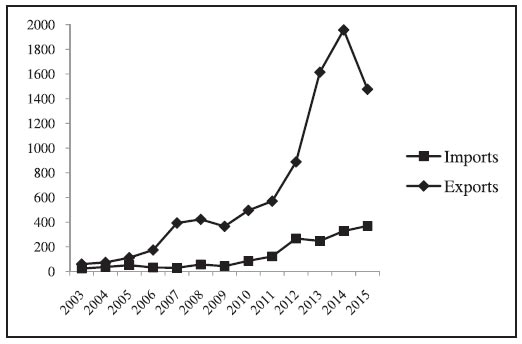
Source: WITS software. https://wits.worldbank.org/WITS/WITS/Restricted/Login.aspx UNCOMTRADE Database by United Nations Statistics Division (UNSD), data obtained using
Table 1: India's imports of coal and pulses from Mozambique (in US$ million)
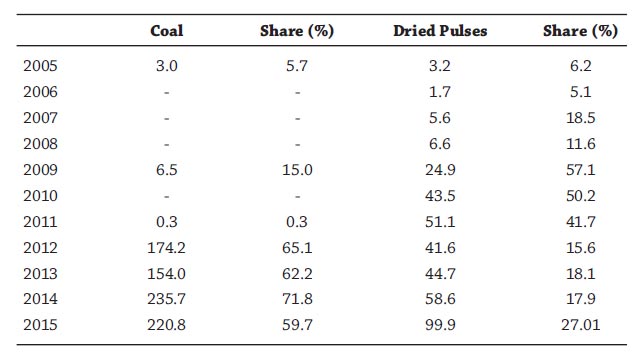
Source: Author's own,using data from UNCOMTRADE Database (https://wits.worldbank.org/WITS/WITS/Restricted/Login.aspx)
Mozambique is also a leading destination for Indian foreign direct investment (FDI), 9 second only to Mauritius. India is the eighth largest investor in Mozambique; in 2014,this 10 investment was estimated at US$ 1.4 billion. Indian companies also have considerable stakes in the country's energy sector. In 2014, ONGC Videsh Ltd. and Oil India Ltd. acquired a 20-percent participating stake in Area 1 of the Rovuma gas block at US$ 5.07 billion; this is in addition to the 10 percent already held by 11 Bharat Petro Resources Limited since 2008. Further, International Coal Ventures Private Ltd., a consortium of Steel Authority of India Ltd., National Thermal Power Corporation Ltd., National Minerals Development Corporation, Coal India Ltd. and Rashtriya Ispat Nigam Ltd., acquired a 65-percent stake in Benga, Zambeze, and Tete mines in 2014. 12
Development cooperation is also an important feature of India's economic relations with Mozambique. For one, India has extended concessional credit lines worth US$ 639.4 million to Mozambique (Table 2). Two of these projects—the setting up of the Technology Development & Innovation Centre (TDIC) in the Maluane Science and Technology Park and a Solar Photovoltaic
Table 2: EXIM Bank of India's operative credit lines in Mozambique
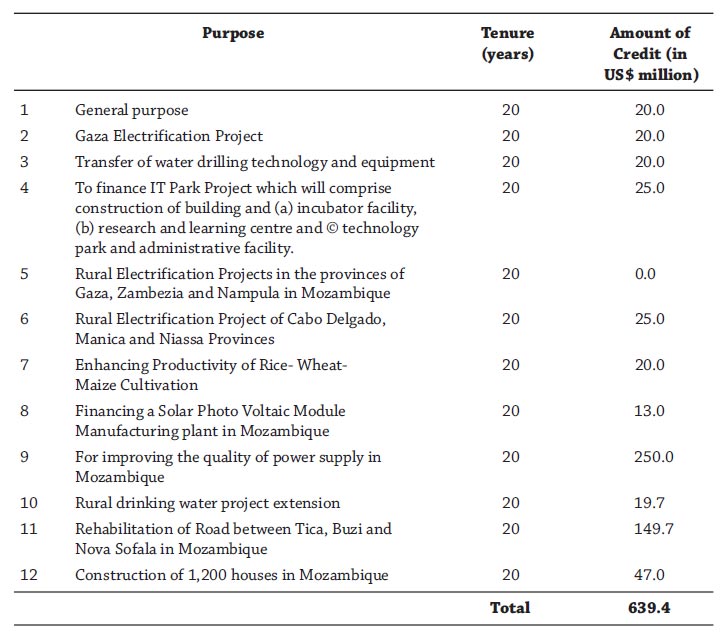
Source: Compiled from EXIM Bank database (www.eximbankindia.in/sites/...files/Operative%20LOCs-05.02.2016.xlsx)
panel assembly plant near Maputo, worth US$ 25 million and US$ 13 million, respectively— have been completed and handed over to the 13 Mozambican government. In 2015, India trained 30 Mozambican nationals under the Indian Technical and Economic Cooperation 14 programme (ITEC). India also provides scholarships for graduate, post-graduate and research studies under the Africa Scholarship Scheme of the Indian Council for Cultural Relations (ICCR) and the Indian Ocean Rim Association (IORA). Short-term training programmes and CV Raman Fellowships are also provided to Mozambican nationals.
Kenya has often been regarded as one of Africa's success stories because of its high grow th rate suppor ted primarily by agriculture, which is among the most sophisticated in Africa. The other sectors that contribute to Kenya's growth include forestry and fishing, transportation and storage, real 15 estate, and wholesale and retail trade. Horticulture contributes the highest percentage of Kenya's agricultural gross domestic product (33 percent), followed by food crops (32 percent) and industrial crops 16 (17 percent). The country also has a vibrant private sector and acts as a regional hub for trade and finance in East Africa. Kenya's membership in both the East African Community and the Common Market for Eastern and Southern Africa makes it an attractive base for investors looking for easy access to the East and Central African 17 markets.
India's exports to Kenya grew rapidly from US$ 213.8 million in 2003 to US$ 3,183.4 million in 2015 at a compound annual growth rate of 25.2 percent (Figure 2). Like in the case of Mozambique, petroleum oils (54.1 percent) and pharmaceutical products (9.3 percent) account for the bulk of the Indian exports to Kenya. Meanwhile, Indian imports from Kenya grew modestly, from US$ 36.2 million in 2003 to US$ 111.7 million. India's imports from Kenya are mainly edible vegetables and certain roots (33.7 percent), inorganic chemical compounds of precious metals (18.5 percent), and coffee (14.9 percent).
Figure 2: India's bilateral trade with Kenya from 2003 to 2015 (in US$ million)

Source: UNCOMTRADE Database by United Nations Statistics Division (UNSD) (https://wits.worldbank.org/WITS/WITS/Restricted/Login.aspx)
Kenya has consistently attracted relatively 18 high levels of FDI. In fact, it was a favoured destination for Indian investment even in the late 1960s when the country's FDI to Africa was minuscule. The Birla Group was the most active Indian company during that time. In 1969, Birla entered into a joint-venture, Pan- Paper, with the Kenyan government and the Wo r l d B a n k I n t e r n a t i o n a l F i n a n c e Corporation through a local subsidiary, Orient 19 Paper. The joint-venture would eventually become E ast A fr ica's big gest paper manufacturer. However, Indian investment in Kenya tapered off in the following two decades. At present, several Indian companies are making investments in Kenya, such as Essar Energy, Magadi Soda Company, Bharti Airtel, Reliance Industries Ltd., Power Grid Corporation of India, Karuturi Global Ltd, and Jain Irrigation System Ltd. In 2010, the government of India also extended a concessional credit line worth US$ 61.6 20 million for the Kenyan power sector. Kenya is also a part of the Pan African e-Network project which was launched in 2007.
Tanzania experienced relatively stable and high growth performance over the last decade (6.5 percent per annum). Tourism is the top source of foreign exchange for the country but agriculture is the main source of livelihood for 22 about 70 percent of the households. Although the rate of poverty has declined in recent years, the absolute number of the poor has not changed, mainly due to high population growth. The country is also rich in natural resources such as oil, gas, and uranium. Moreover, it has the longest shoreline on the Indian Ocean, which makes it critical to the security and geo-strategic environment of the region. 23
As shown in Figure 3, India's exports to Tanzania grew rapidly beginning in 2006 and peaked at US$ 3,713.8 million in 2014. The pattern is familiar: petroleum oils (45.7 percent) and pharmaceuticals (9.8 percent) account for the bulk of Indian exports to Tanzania. Of all medicines and other pharmaceutical products imported by Tanzania, about 36 percent are sourced from 24 India. There was a substantial increase in Indian imports from Tanzania from 2012, due largely to the rapid increase in gold imports. In 2015, India's gold imports from Tanzania were valued at US$ 539.5 million, which accounted for 53.7 percent of all Indian imports from the country. Other important items are cashew nuts and pulses.
Figure 3: India's bilateral trade with Tanzania from 2003 to 2015 (in US$ million)
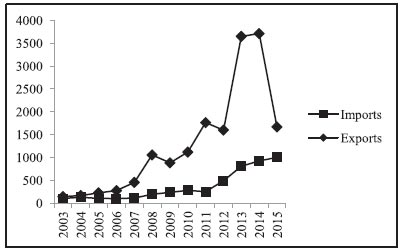
Source: UNCOMTRADE Database by United Nations Statistics Division (UNSD) (https://wits.worldbank.org/WITS/WITS/Restricted/Login.aspx)
India is the third largest investor in Tanzania after the United Kingdom and China, with its cumulative investment from 1990 to 2014 valued at US$ 2,000.04 million. These investments have supported the employment of over 54,176 people in 426 25 projects. Indian firms have also invested about US$ 2,497 million in export processing 26 zones across the country, and the EXIM Bank has extended lines of credit worth US$ 523 million for water projects and procurement of tractors and other vehicles (Table 3). Tanzania is one of the largest beneficiaries of training slots allocated under ITEC programmes, and also avails of a number of such training slots offered under India Africa Forum Summit. In 2014-15, Tanzania had 330 slots under the ITEC programme out of which 285 were for civilian officers and 39 for defence officers.27
Table 3: EXIM Bank of India's operative credit lines in Tanzania
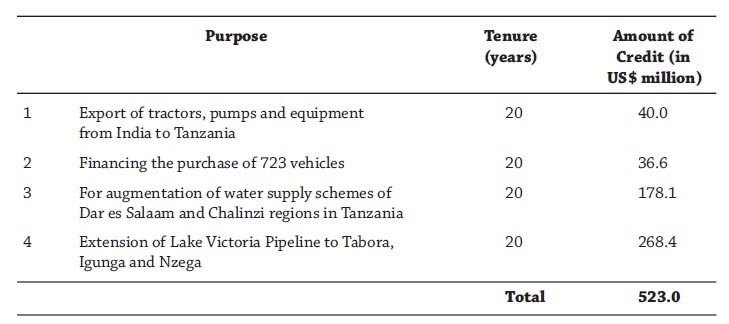
Source: Compiled from EXIM Bank database, www.eximbankindia.in/sites/...files/Operative%20LOCs-05.02.2016.xlsx
Unlike the other three African countries studied in this paper, South Africa is a regional power in its own right. India cooperates with South Africa at fora such as India Brazil South Africa (IBSA) and Brazil Russia India China South Africa (BRICS). However, South Africa's rate of inequality remains among the highest in the world. The top decile of the population accounts for 58 percent of the country's income, while the bottom decile accounts for 0.5 percent, and the bottom half, less than eight percent 28.
Commercial relations between India and South Africa have flourished in the last decade. India's exports to South Africa grew rapidly from US$ 464.4 million in 2003 to US$ 5,730.3 million in 2013 (Figure 4). The bulk of these exports comprise petroleum oils (20.4 percent), vehicles (20.1 percent), and pharmaceuticals (12.5 percent). Meanwhile, India's imports from South Africa also grew, from US$ 1,945.5 million in 2003 to US$ 9,306.3 million in 2011. It would eventually decline due to a drastic fall in gold imports (Figures 4 and 5). Coal and gold are India's main imports from South Africa, accounting for about 35.2 percent and 27.6 percent, respectively, of India's total imports from South Africa in 2015. There was a dramatic decline in India's gold imports from South Africa as India shifted much of its gold imports to Switzerland which has the best quality gold refiners. South Africa is largely a gold miner and not a refiner. 29
Figure 4: India's bilateral trade with South Africa from 2003 to 2015 (in US$ million)
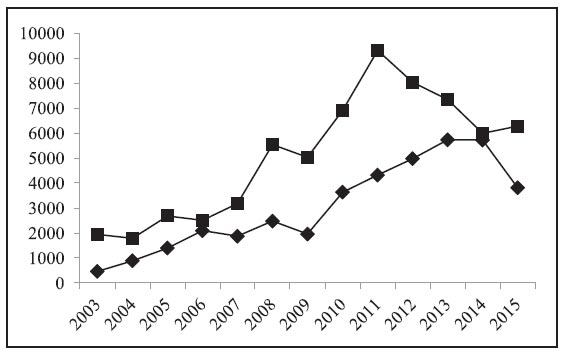
Source: UNCOMTRADE Database by United Nations Statistics Division (UNSD) (https://wits.worldbank.org/WITS/WITS/Restricted/Login.aspx)
Figure 5: India's gold imports from South Africa from 2003 to 2015 (in US$ million)
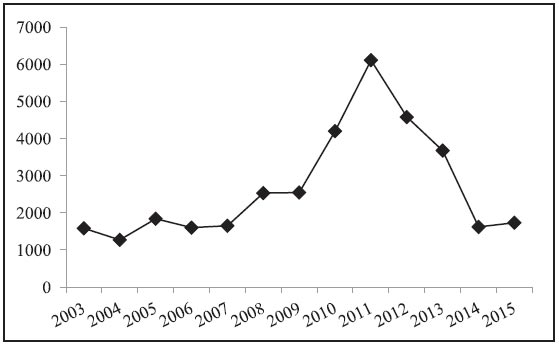
Source: UNCOMTRADE Database by United Nations Statistics Division (UNSD) (https://wits.worldbank.org/WITS/WITS/Restricted/Login.aspx)
Major Indian investors in South Africa are Tata (automobiles, information technology, hospitality, and ferrochrome plant), Mahindra (automobiles), and Ranbaxy and 30 Cipla (pharmaceuticals). India is a key supplier of affordable essential drugs to South Africa. This partnership on medicine access dates back to 2001, when Indian generic drug manufacturer, Cipla, volunteered to sell the generic version of antiretroviral (ARV) drugs 31 for less than a dollar a day. Today, the South African government is heavily dependent on Indian-made ARVs for its national treatment programmes and India is the principal source of pharmaceutical drugs (by volume) for South Africa. Unlike the other African countries being studied, South Africa has a number of leading companies that have made substantial investments in India. These include SAB Miller (breweries), ACSA (for improvements of Mumbai's international air p or t), S A NL AM and O ld Mutual (insurance), ALTECH (TV set top boxes), Adcock Ingram (pharmaceuticals), and Rand Merchant Bank (banking).32
KEY DIMENSIONS OF INDIA'S RELATIONS WITH EAST AND SOUTH AFRICA
The following section studies three critical dimensions of India's relations with east and south Africa viz. energy, food, and maritime security.
Energy cooperation with Africa became a critical component of the partnership from the 1990s. With higher growth rates in the era of liberalisation, India's energy requirements increased dramatically and, consequently, its dependence on imports rose manifold. In 2010-11, import dependence for crude oil, coal, and natural gas was about 79 percent, 18 33 percent, and 15 percent, respectively. At the same time, the instability in the West Asian region prompted India to diversify their energy imports. Thus, Africa, with its proximity to India and its abundant energy reserves, became a particularly attractive source. As observed in the first section of this paper, India imports significant quantities of coal from Mozambique and South Africa which are critical for its power sector. India's engagement with Mozambique is particularly important because it has about 100 trillion 34 cubic feet of proved natural gas resources. Indian state-owned oil and gas firms, ONGC Videsh Limited and Oil India Limited, have already made significant investments in the Rovuma gas field in Mozambique. India is also a major exporter of refined petroleum oils to African countries. As observed in section 1, petroleum oil exports account for the bulk of India's exports to Mozambique, Kenya, Tanzania, and South Africa, respectively. A joint study by CII and WTO also found that India's primary exports to East and Southern 35 Africa are petroleum products.
For a deeper understanding of India's relations with Africa in the context of energy security, it is important to view energy security beyond the narrow lens of demand and supply. The International Energy Agency defines 'energy security' as the “the uninterrupted availability of energy sources 36 at an affordable price”. It is important, however, to bear in mind that for developing countries such as India as well as African countries, the issue of energy security goes beyond macro concerns. Rather, it begins with the ability to put in place distribution networks, ensure supplies, and provide adequately priced energy to the large sections of the population who live outside the cleanenergy consumption network.
Millions of people in India and Africa lack access to modern energy technologies (Table 4). The electrification rates in these countries are low. The picture is even grimmer in the case of clean cooking technologies. The proportion of population relying on the traditional use of biomass for cooking was 96 percent in Mozambique and Tanzania, followed by Kenya at 84 percent. In India, 754 million or about 67 percent of the population continue to rely on the traditional use of biomass for cooking. Thus, the definition of energy security provided in the Integrated Energy Policy is more appropriate for developing countries: "We are energy secure when we can supply lifeline energy to all our citizens irrespective of their ability to pay for it as well as meet their effective demand for safe and convenient energy to satisfy their various needs at competitive prices, at all times and with a prescribed confidence level considering shocks and disruptions that can be reasonably expected”.37
Table 4: Population without access to electricity and clean cooking technologies (2013)
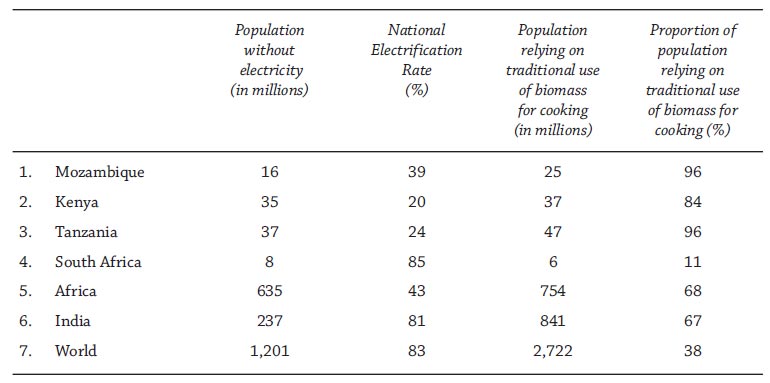
Source: International Energy Agency, World Energy Outlook 2015
Therefore, energy partnership between India and Africa must be located within the context of India's growing profile as a global champion of clean energy. At the Conference of Parties 21, India announced the formation of the International Solar Alliance with the aim of making clean power affordable and universally accessible by 2030. Moreover, India is playing an important role in Africa's energy security by supporting energy access programmes through renewable energy technologies. India has extended credit lines to facilitate the construction of power transmission lines in Kenya, rural electrification projects, and solar photovoltaic module manufacturing plants in Mozambique. Prime Minister Narendra Modi's interaction in 2016 with the 'Solar Mamas' in Tanz ani a hig hlig hts the development dimension of energy cooperation between India and Africa. So far, more than 160,000 people have received solar electrification through the 'Barefoot 38 Approach'. Training illiterate and semiliterate African women to become solar engineers also makes a tremendous impact on the lives of the poorest communities in Africa. In a nutshell — both India and Africa are critical to each other's energy security.
FOOD SECURITY
The last decade saw a marked increase in cooperation between India and African countries in the area of food security, with trade in food articles growing steadily since 39 2000. It was no surprise that food security was a key theme in all three India-Africa Summits that have taken place in succession in 2008, 2011, and 2015. However, the signing of a long-term agreement to procure pulses from Mozambique during Prime Minister Modi's visit to Africa generated much more attention to this critical dimension of India-Africa partnership. As observed in Section I, Mozambique and Tanzania are already important sources of pulses for India. But the long-term agreement to procure pulses from Mozambique is particularly important because India is chronically short of pulses, which is widely preferred as the main source of protein. The gap between domestic demand and supply of pulses is likely to grow further in the future because production is unlikely to 40, 41 rise substantially in the short term. The agreement is also favourable to Mozambican farmers because it is based on the cooperative model under which India will identify a network of Mozambican farmers and help them by providing improved seeds and technology as well as assist them to produce pulse varieties which suit Indian tastes. Further, India will procure pulses at a rate not less than the minimum support price offered to Indian farmers. As a result, Mozambican farmers will face minimum risks because price is assured, as well as import quantity.
Pulses are no doubt an important dimension of India's engagement with East Africa in the area of food security. India, for its part, is making an important contribution towards improving food security in these countries by making agricultural technology more accessible to them. Two institutions, the International Crop Research Institute for the Semi - arid Tropics (ICRISAT) and International Livestock Research Institute (ILRI), lead India-Africa cooperation in agriculture and food security. ILRI, for example, regularly conducts programmes in Mozambique, Tanzania, and Kenya on reducing poverty and improving food security through the sustainable use of livestock. Meanwhile, the ILRI's IM Goats project focuses on strengthening goat value chains in India and Mozambique in order to increase incomes of the rural poor, particularly the women, who depend on goat husbandry for their livelihood.
India's cooperation with Tanzania and Kenya in the area of food security has mainly focused on the dairy sector. ILRI's milk IT project, for instance, aims to enhance diarybased livelihoods via intensification of small holder production. Under a World Bankfunded knowledge exchange programme between India and Tanzania, Tanzanian officials also gained firsthand knowledge about India's 'white revolution' and implemented diary reforms in Tanzania based on the new knowledge and skills acquired during the knowledge exchange programme. Moreover, India is contributing towards agricultural mechanisation in Tanzania by providing tractors to its farmers; the first batch of 288 Indian tractors were sent to 43 Tanzania in 2010. The Kenyan government has also derived inspiration from Indian experience in the dairy sector and is partnering with India to increase its milk production. For one, the India-Kenya Dairy Innovation Bridge Programme seeks to transform the dairy industry in Kenya by employing major innovations adopted in India's dairy sector. The project aims to strengthen the entire dairy value chain in Kenya with a special emphasis on increasing the incomes of small farmers and achievement of nutritional security.
EXIM Bank's concessional credit lines are also playing an important role in reducing food insecurity in East Africa. For instance, EXIM Bank has extended a concessional loan of US$ 20 million to enhance productivity in the cultivation of rice, wheat, and maize in Mozambique. EXIM Bank has also extended a concessional credit line worth US$ 40 million for export of tractors, pumps, and equipment from India to Tanzania.
MARITIME SECURITY COOPERATION
Greater maritime security cooperation featured prominently during the Prime Minister's 2016 visit to Africa. After all, this region forms a part of India's strategic maritime frontier and is the main supply line of energy and trade for India. About 89 percent of India's oil imports are routed 44 through the Indian Ocean region. Similarly, India also imports significant quantities of coal from Mozambique and South Africa. Therefore, ensuring the safety and security of the sea lanes of communication is of paramount importance for the Indian economy. Piracy and armed robbery by Somalian pirates are the main security concerns in the Indian Ocean. To counter piracy, India has maintained a naval presence in the piracy-prone areas of the Gulf of Aden beginning in 2008. 45
India's maritime relations with east and south African countries have expanded over the years. Relations with Tanzania improved with the Indian President's visit to Tanzania in 2004 which led to an agreement for increased training of Tanzanian military personnel in India. India also provided joint patrols off the Mozambique coast during the African Union Summit in Maputo in 2003 and for the World Economic Forum Meeting in 2004. India signed a defence agreement with Mozambique in 2006 and since then the Indian Navy organises regular patrols off Mozambique's coast and supplies it with arms and services. India trains Kenyan naval officers and provides limited defence aid to Kenya but has largely failed to project itself as a key maritime partner in the past. During his visit to Kenya in 2016, PM Modi mentioned the need for greater maritime cooperation between India and Kenya and signed a defence cooperation agreement to promote greater staff exchanges, sharing of expertise and experiences, training and institution building, cooperation in hydrography, and supply of 46 equipment. According to a 2012 report by the Institute for Security Studies, the Kenyan shipping industry loses between US$ 300 million and US$ 400 million a year due to 47 piracy. Closer security cooperation between the countries will thus be beneficial to the Kenyan economy.
India and South Africa have also conducted combined naval drills in 2005, 2008, and 2010. However, given South Africa's position as a regional leader, India should aim to utilise South Africa's influence in Sub-Saharan Africa to create a consensus for India's leadership in the Indian Ocean. Moreover, India could also learn from South Africa's recent efforts in blue economy.
Securing the sea-lanes of communication is undoubtedly critical for India, but trade convoy protection is not the only aspect of India's security policy in the Indian Ocean region. In recent years, the emphasis on maritime development and 'blue economy' has grown rapidly. South Africa can serve as a good example for India in this regard. The South African government launched 'Operation Phakisa', a project aimed at developing its ocean economy in 2014. According to the estimates of the South African government, oceans have the potential to contribute 177 billion rands (approx. US$ 12.8 billion) to the South African GDP and create about 1 million 49 jobs by 2033. In order to tap into the potential of the country's vast coastline, the South African government is bringing together experts from the government, businesses, labour, and academia to work together in experimental laboratories. Four critical areas have been identified viz. marine transport and manufacturing, offshore oil and gas exploration, aquaculture work stream, marine protection services, and ocean governance. India should try to partner with South Africa in each of these sectors.
For India to be a successful security provider in the Indian Ocean region, it needs to adopt a comprehensive approach which places adequate emphasis on both security and development issues. According to analysts like Abhijit Singh, the need of the hour is a holistic model which includes security, infrastructure creation, industrial capacity building, marine development, strengthening of legal frameworks and institutions in Africa, and sustainable management of maritime resources.50
CONCLUSION
This paper finds that economic linkages between India and the African countries under consideration have grown remarkably in the last decade. Trade, for example, is flourishing, a l b e i t domi n ate d by t he s ame fe w commodities (coal, gold, and refined petroleum oils). Many Indian companies have also invested heavily in these countries, mainly in the resource sector.
Energy security is no doubt at the centre of India's engagement with east and south Africa. The paper underscores, however, the importance of looking beyond mere resource imports from African countries. African countries are not only important sources of energy but also a key destination of refined petroleum oils from India. Moreover, India is playing an important role in providing the poor populations of these countries access to clean energy. Similarly, imports of pulses are critical for India's food security but at the same time, India is also playing an important role in addressing Africa's food insecurity by sharing knowledge and making new technology more accessible to African farmers. Even in the case of maritime cooperation, this paper argues, India's interests are not limited to securing energy and resource shipments. The emphasis on 'blue economy' is growing rapidly. As economics is the key driver of India's relations with east and southern Africa, closer economic and security ties between India and these countries will only serve in their mutual interests.
ENDNOTES
1. Nivedita Ray, India and East Africa Partnership: Opportunities and Challenges, (New Delhi: Vij Books
India Pvt Ltd)
2. Ministry of External Affairs,“Annual Report 2015-16”, Government of India (2016),
https://mea.gov.in/Uploads/PublicationDocs/26525_26525_External_Affairs_English_AR_2015-
16_Final_compressed.pdf
3. “Hamid Ansari leaves for Morocco, Tunisia”, The Hindu, May 30, 2016, http://www.thehindu.com/
news/national/vicepresident-hamid-ansari-leaves-for-morocco-tunisia/article8666286.ece
4. “President to visit 3 African countries from June 12”, The Hindu, September 16, 2016,
http://www.thehindu.com/news/national/president-pranab-mukherjee-to-visit-ghana-cote-divoireand-
namibia-from-june-12/article8705349.ece
5. Nivedita Ray, India and East Africa Partnership: Opportunities and Challenges, (New Delhi: Vij Books
India Pvt Ltd)
6. Ajay Kumar Dubey, India and Africa's Partnership: A Vision for a New Future, (New Delhi: Springer,
2013)
7. United Nations Conference on Trade and Development. “The Least Developed Countries Report 2015:
Transforming Rural Economies”, UNCTAD/LDC/2015, United Nations Conference on Trade and
Development (2015)http://unctad.org/en/PublicationsLibrary/ldc2015_en.pdf
8. United Nations. “State of the Least Developed Countries 2016”, United Nations Office of the High
Representative for the Least Developed Countries, Land Locked Developing Countries and Island
Developing States (UN-OHRLLS), 2016, http://unohrlls.org/custom-content/uploads/2016/08/
State-of-LDCs2016.pdf
9. Chris Alden and Raj Verma, “India's pursuit of Investment opportunities in Africa,” in India and Africa's
Partnership: A Vision for a New Futureed. Ajay Kumar Dubey and Aparajita Biswas (New Delhi:
Springer, 2013), 61-82
10. Ministry of External Affairs. “India-Mozambique relations,” Government of India (2016),
https://www.mea.gov.in/Portal/ForeignRelation/Mozambique_13_01_2016.pdf
11. Ibid.
12. Steel Authority of India. “ICVL acquires Rio Tinto's 2.6 Billion Tonnes coal resource in Mozambique,”
Press Release, July 30 2014, https://www.sail.co.in/sail-press-release/icvl-acquires-riotinto%
E2%80%99s-26-billion-tonnes-coal-resource-mozambique
13. Ministry of External Affairs, “India-Mozambique relations,” Government of India (2016),
https://www.mea.gov.in/Portal/ForeignRelation/Mozambique_13_01_2016.pdf
14. Ibid.
15. World Bank, “Overview”, http://www.worldbank.org/en/country/kenya/overview
16. Mwangi S. Kimenyi and Josephine Kibe, “Africa's Powerhouse”, Brookings Institution, 2014,
https://www.brookings.edu/opinions/africas-powerhouse/
17. Nivedita Ray, India and East Africa Partnership: Opportunities and Challenges, (New Delhi: Vij Books
India Pvt Ltd)
18. Mwangi S. Kimenyi and Josephine Kibe, “Africa's Powerhouse”, Brookings Institution, 2014,
https://www.brookings.edu/opinions/africas-powerhouse/
19. Gerard McCann, “Ties that bind or binds that tie? India's African engagements and the political
economy of Kenya,” Review of African Political Economy 37 (2010): 465
20. Ministry of External Affairs. “India-Kenya relations,” Government of India, https://www.mea.gov.in/
Portal/ForeignRelation/India-Kenya_Relations.pdf
21. World Bank, “Overview”,http://www.worldbank.org/en/country/tanzania/overview
22. Ibid.
23. Nivedita Ray, India and East Africa Partnership: Opportunities and Challenges, (New Delhi: Vij Books
India Pvt Ltd)
24. Ministry of External Affairs. “India-Tanzania relations,” Government of India (2016),
https://www.mea.gov.in/Portal/ForeignRelation/Tanzania_15_01_20162016.pdf
25. Ibid.
26. Ibid.
27. Ibid.
28. World Bank, “Overview”,http://www.worldbank.org/en/country/southafrica/overview
29. Asit Ranan Mishra, “Along with exports, India's imports too see eastern shift,” Livemint, May 17, 2013
http://www.livemint.com/Politics/vOKjZF6sx3ZTd0eHOnjdkJ/Along-with-exports-Indias-importstoo-
see-eastern-shift.html
30. Ministry of External Affairs. “India-South Africa relations”, Government of India,
https://www.mea.gov.in/Portal/ForeignRelation/India-SouthAfrica_Relations.pdf
31. Tanoubi Ngangom, “India and Africa's partnership for access to medicines”, The British Medical
Journal (BMJ), http://blogs.bmj.com/bmj/2016/08/09/tanoubi-ngangom-on-india-and-africaspartnership-
for-access-to-medicines/
32. Ibid.
33. The Energy and Resources Institute.”Energy Security Outlook: Defining a Secure and Sustainable
Energy Future for India", (New Delhi: TERI Press, 2015), https://bookstore.teri.res.in/docs/books/
ENERGY%20SECURITY%20OUTLOOK.pdf
34. U.S. Energy Information Administration, https://www.eia.gov/beta/international/ analysis.cfm?
iso=MOZ
35. “India-Africa: South-South Trade and Investment for Development,” (New Delhi: CII/WTO, 2013),
https://www.wto.org/english/tratop_e/devel_e/a4t_e/global_review13prog_e/india_africa_
report.pdf
36. International Energy Agency, “What is Energy Security,” http://www.iea.org/topics/energysecurity/
subtopics/whatisenergysecurity/
37. “Report of the Expert Committee on Integrated Energy Policy,” New Delhi: Planning Commission,
August 2006, http://planningcommission.nic.in/reports/genrep/rep_intengy.pdf
38. Barefoot College, “Solar Mamas of Africa to meet Prime Minister Narendra Modi on his visit to
Tanzania,” http://www.barefootcollege.org/solar-mamas-of-africa-to-meet-prime-ministernarendra-
modi-on-his-visit-to-tanzania/
39. Malancha Chakrabarty and Vidisha Mishra, “India-Africa Partnership for Food Security: Issues,
Initiatives and Policy Directions”, ORF Occasional Paper 95, June 2016, http://cf.orfonline.org/wpcontent/
uploads/2016/06/ORF_OccasionalPaper_95.pdf
40. Surbhi Mittal, “Demand-Supply Trends and Projections of Food in India”, Indian Council for Research
on International Economic Relations, Working Paper No. 209, March 2008, http://www.eaber.org/
sites/default/files/documents/ICRIER_Mittal_2008_02.pdf
41. Tulsi Lingareddy, “Pulses: Need for Production Expansion”, Economic and Political Weekly, vol l no 35,
August 29 2015, http://www.epw.in/system/files/pdf/2015_50/35/Pulses_Need_for_
Production_Expansion.pdf
42. M i c h a e l Wo n g , “ H o w T a n z a n i a L e a r n e d f r o m I n d i a ' s W h i t e R e v o l u t i o n ” ,
http://knowledgesharingfordev.org/Data/wbi/wbicms/files/drupal-acquia/wbi/document_
repository/art_of_knowledge_exchange_-_case_study_-_tanzania.pdf
43. Arnauld Bebian, “Tanzania-India: A Rewarding Relationship,” Inter Press Service News Agency, May 27
2011 http://www.ipsnews.net/2011/05/tanzania-india-a-rewarding-relationship/
44. Alex Vines, “India's security concerns in the western Indian Ocean” in India in Africa: Changing
geographies of Power, eds. Emma Maudsley and Gerard McCann (Pambazuka Press, 2013), 187-202.
45. Nivedita Ray, India and East Africa Partnership: Opportunities and Challenges, (New Delhi: Vij Books
India Pvt. Ltd)
46. Press Statement by Prime Minister during his visit to Kenya, July 11 2016, http://mea.gov.in/
outoging-visit-detail.htm?27008/Press+Statement+by+Prime+Minister+during+his+visit+
to+Kenya+July+11+2016
47. “Kenya and the Pest of Piracy: A prospective partner for peace”, Situation Report, Institute for Security
Studies, February 2012, https://issafrica.s3.amazonaws.com/site/uploads/22Feb12Kenya.pdf
48. Alex Vines, “India's security concerns in the western Indian Ocean” in India in Africa: Changing
geographies of Power, eds. Emma Maudsley and Gerard McCann (Pambazuka Press, 2013), 187-202.
49. Department of Environmental Affairs. “Operation Phakisa-Oceans Economy”, Government of South
Africa, https://www.environment.gov.za/projectsprogrammes/operationphakisa/oceanseconomy
50. Abhijit Singh, “Modi's Africa visit: The 'Blue-Economy' imperative”, http://www.orfonline.org/expertspeaks/
modis-africa-visit-the-blue-economy-imperative/
The views expressed above belong to the author(s). ORF research and analyses now available on Telegram! Click here to access our curated content — blogs, longforms and interviews.

Dr Malancha Chakrabarty is Senior Fellow and Deputy Director (Research) at the Observer Research Foundation where she coordinates the research centre Centre for New Economic ...
Read More +